

Strapi Reviews & Product Details
Strapi is a free, open-source, and headless/back-end-only CMS that runs on 100% Javascript. Made for developers, it’s fully customizable and provides a robust environment for creating self-hosted and high-performing content APIs. Content creators can easily define models to build rich layouts depending on the data structure they need for their business. Once a content architecture has been set, it’s seamless to write, edit, and manage any content type. Comprehensive frameworks and services from third-party vendors are available to reinforce the content environment and once ready, content can be easily deployed on all cloud platforms or traditional servers.

| Capabilities |
|
|---|---|
| Segment |
|
| Deployment | Cloud / SaaS / Web-Based, Desktop Linux, Desktop Mac, Desktop Windows, On-Premise Linux, On-Premise Windows |
| Support | 24/7 (Live rep), Chat, Email/Help Desk, FAQs/Forum, Knowledge Base, Phone Support |
| Training | Documentation |
| Languages | English |
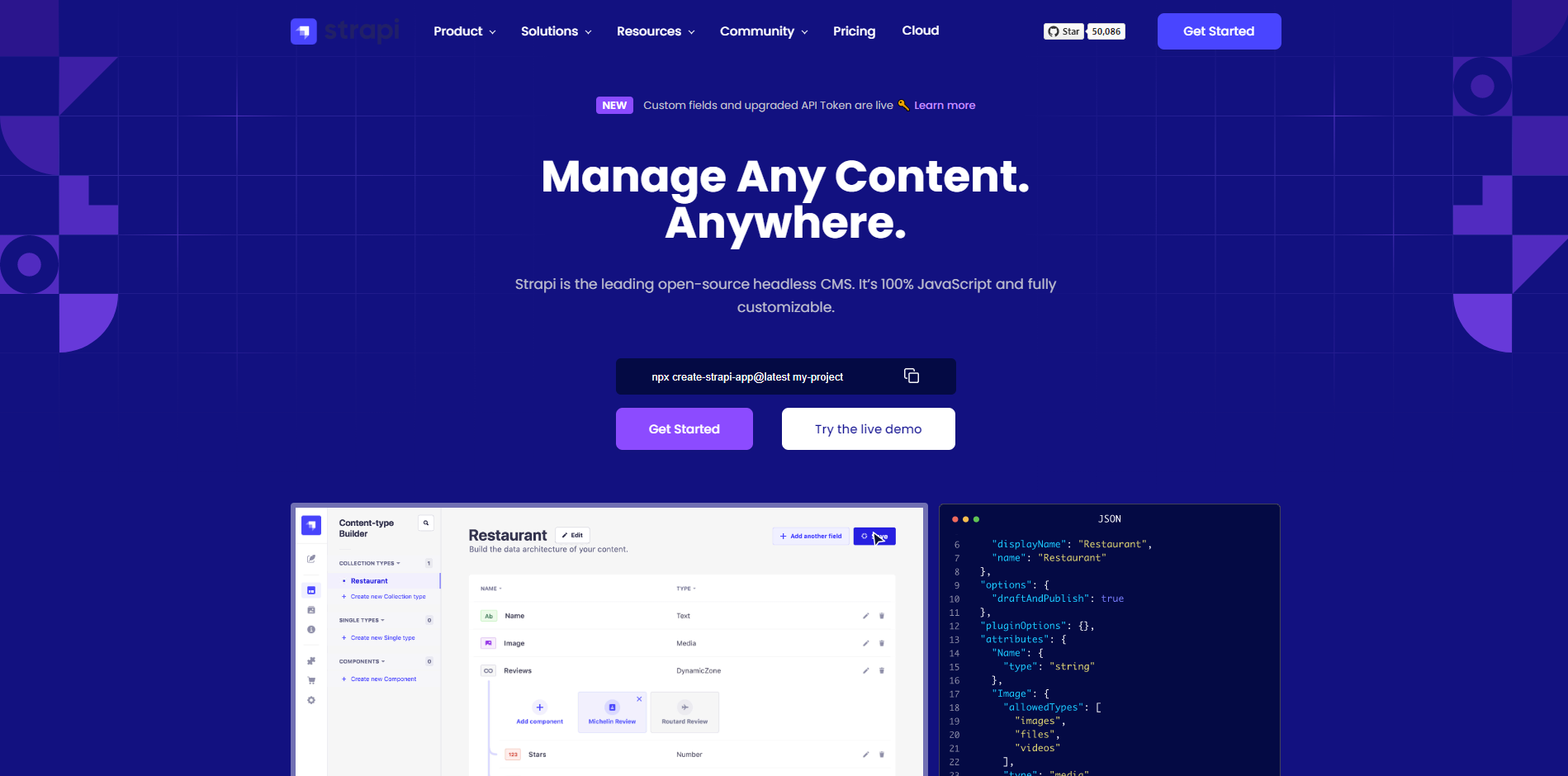
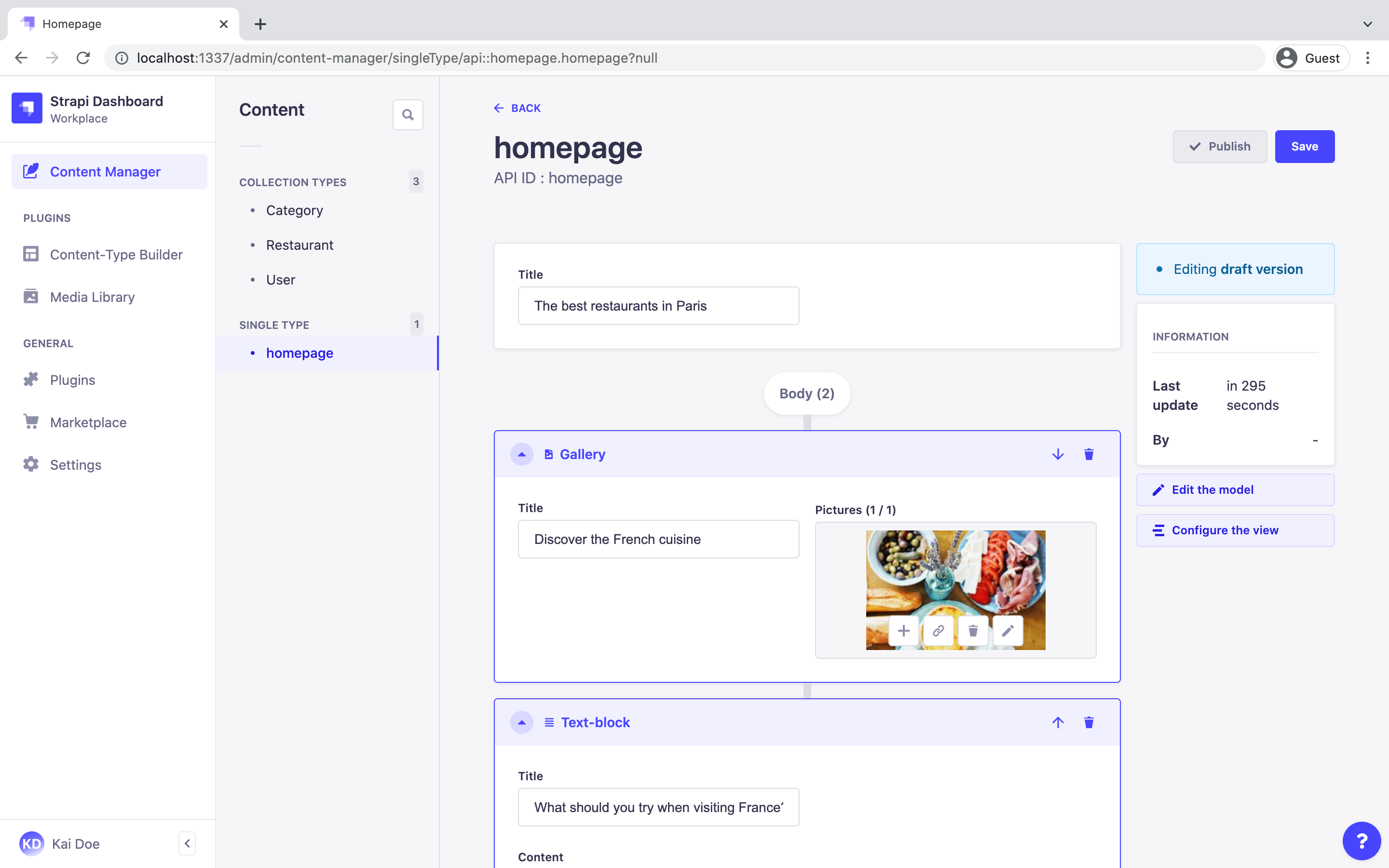
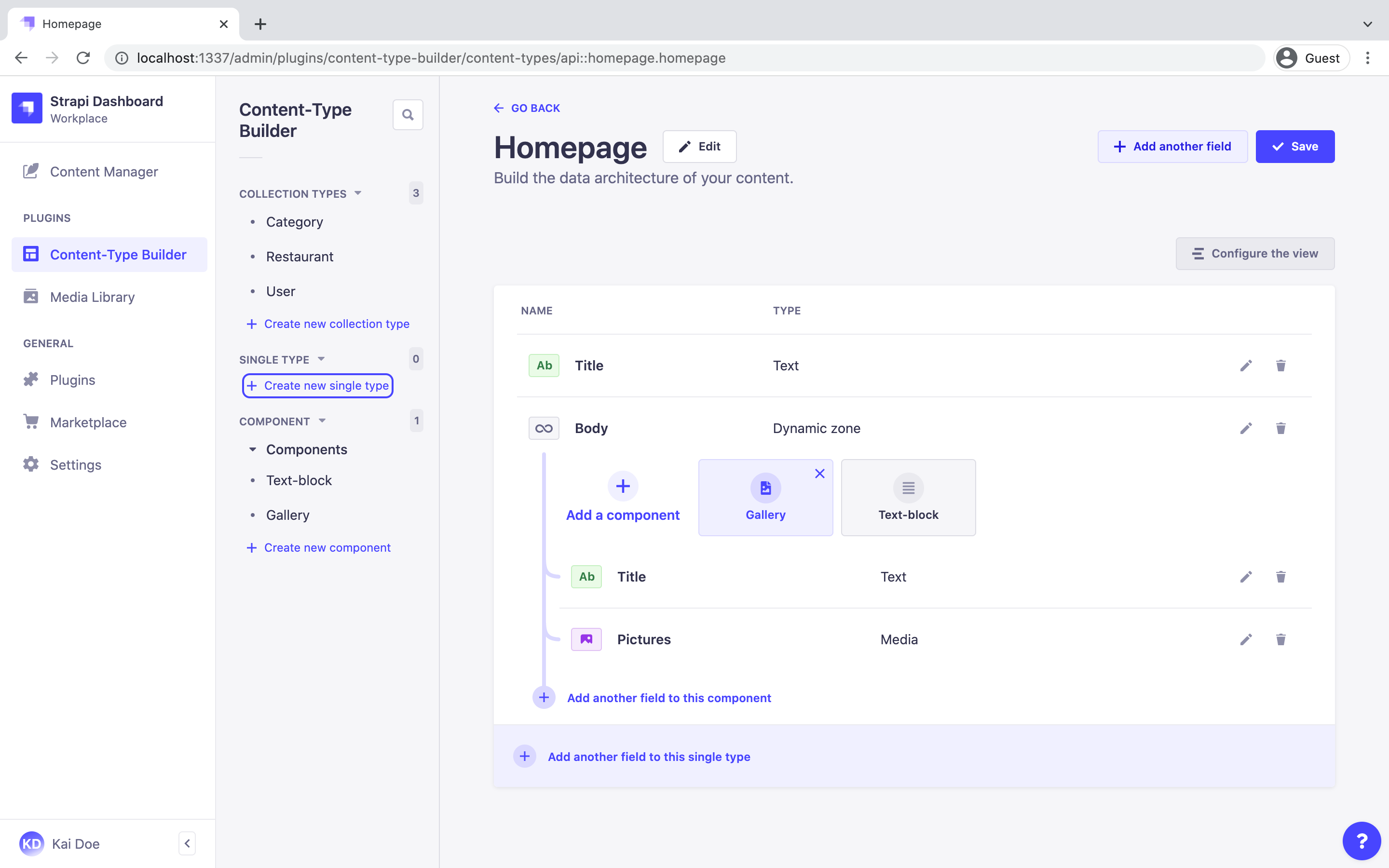
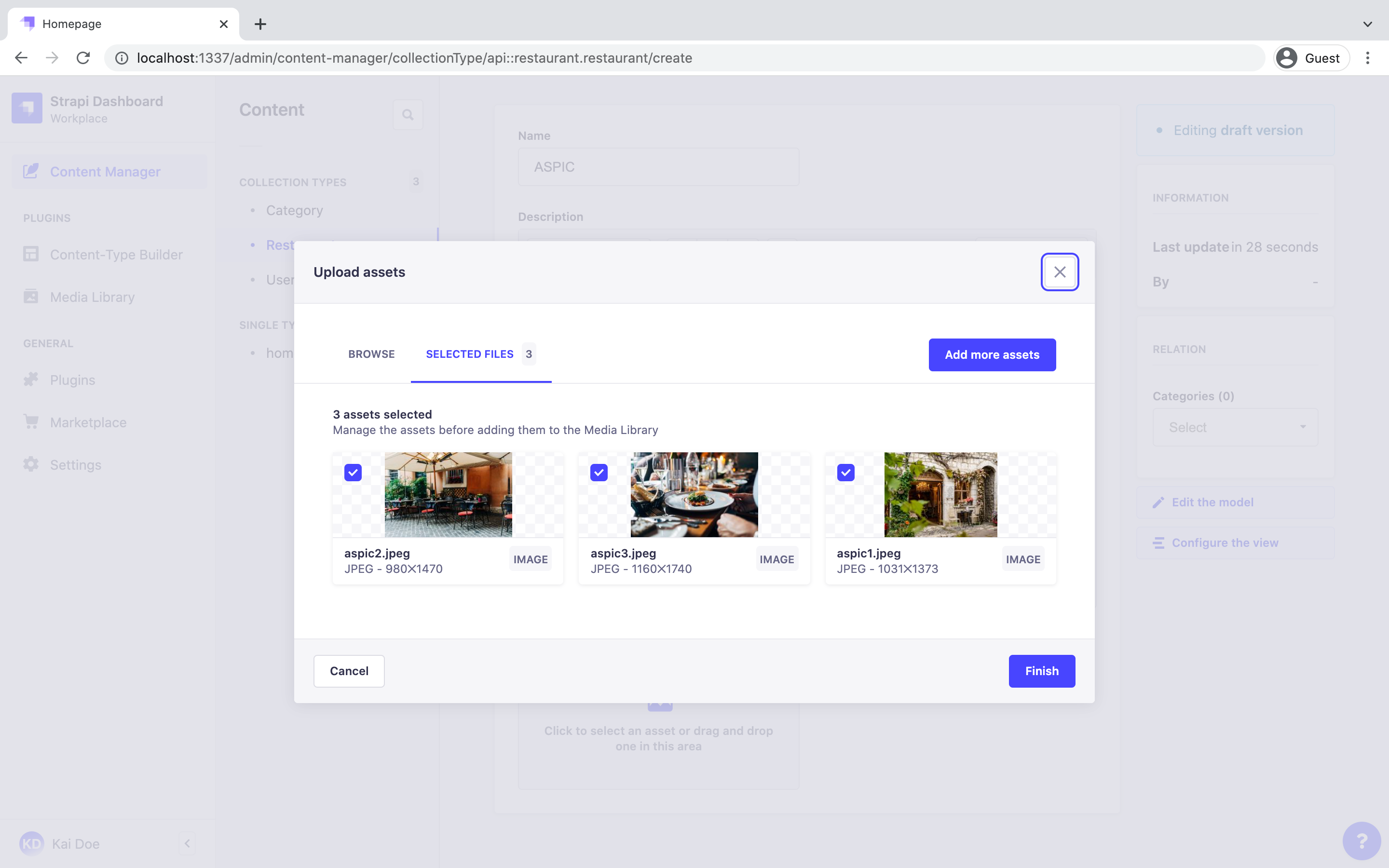
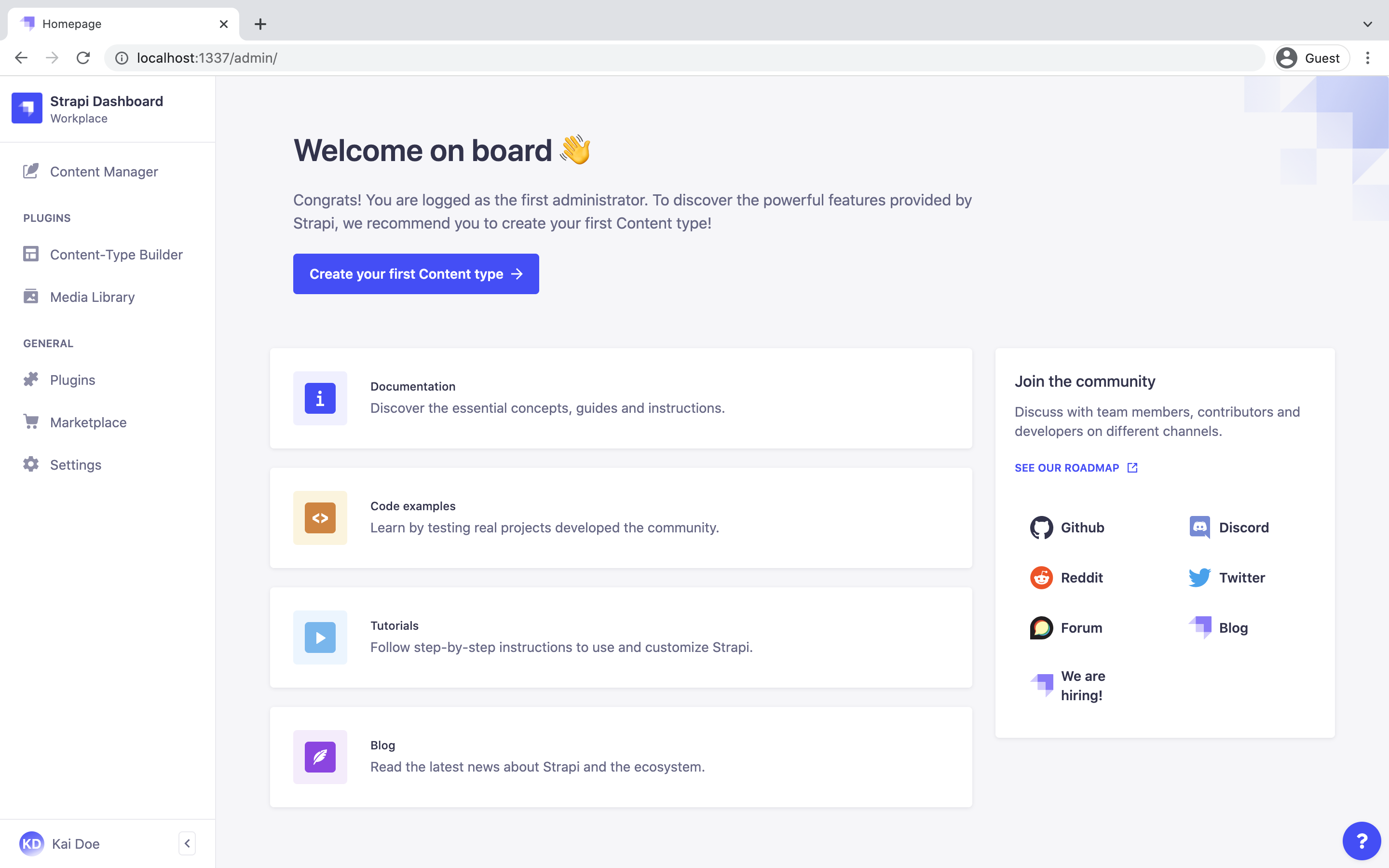

You can easily customize, can create new plugins, and can easily modify the existing UI. Content is easily accessible through REST API or GraphQL.
There are only 3 roles in the free tier.
Building a flexible system that allows multiple types of users to add and edit content. Headless makes it very easy to consume the data. Strapi is the best headless CMS currently because of its fast API development process and its flexibility.
I appreciated the smooth setup process and comprehensive documentation. Compared to other CMS, Strapi has been the most intuitive.
I haven't encountered many dislikes so far but will update with more experience.
I am creating a website for our school's organization. I realized that managing blogs are easier with Strapi.
Quiet complete tool, even in the "community edition" Useful for an education point of view because data and API are decoupled from the presentation site. The set-up is easy, and the tool is highly customizable
The personalization of the admin UI is quite complex (limited documentation, complicated tree view of the files)
- Education point-of-view: quick creation of APIs to develop websites, modern approach for the design of websites with an admin panel - Fast prototyping of a management tools for "portfolio de traces" (in skills-based approach)
Being a non technical person it was tough to figure out the best cms to work with, but with little help Strapi turned out to be amazing. One-click deploy, along with insane flexibility to render content. The UI & UX is also great. It is brilliant to onboard new users and content creators seamlessly. Eagerly awaiting the plugin library updates. For now we are building our customized plugins and its working brilliantly. No tedious permissions based payments, Even the community edition is so well versed to handle small projects.
The media library is a bit tedious for our use case - no folder structure Native latex or maths support is not there, even with CK editor.
We are primarily using it to host simple blog and content pieces such as quizzes, exams etc It is easy and excellent to onboard freelance writers to write the content as required creating the appropriate QC guidelines and hierarchy
Strapi makes it easy to build a backend that can be sophisticated yet is easy to maintain by anyone. You can create new plugins and modify the existing UI to any extent. It's a brilliant combination of Backend (API's) and Admin Portal (to help maintain the data sent on the API's).
I would've loved a bit more plugins as default, like social media management. My use-case includes end-users who manage social media accounts, and something for them within Strapi would've been brilliant. The documentation isn't unambiguous: They say the Admin panel requires 2GB processing in their custom deployment documentation, but in their Heroku documentation (Heroku provides by default 512MB), they don't mention anything.
I'm using it as a demo project for my college. Because its admin panel is straightforward to use, I can use Strapi with my colleagues who don't have computer science backgrounds. Also, the bookshelves (i.e., the databases) in Strapi help immensely in maintaining and encouraging to maintain data.
Its flexibility is key. Having the ability to change copy and imagery, even with a custom-designed website. We've even got plans to use this sort of flexibility to create our own internal training tool, which requires content to be created and changed once or twice a year. Strapi will allow us to grow as our organisation grows. I also like the fact that the application is self-hosted. It means we can control our costs.
The UI is a little difficult to get your head around at first, especially if you're coming from a traditional CMS. We're fortunate in that there are a few people who have used Strapi, but, for new people, it would be best to watch the training videos.
We're giving our content team the ability to define the content across our site. We're also going to consider launching a blog, to have regular content output. Depending on how we grow as an organisation, we may even use Strapi to host and display our internal training content.
Simple interface, customizable power, solid APIs, open-source
Tools for keeping data in sync between different environments are currently lacking
We're using Strapi on a new project, so we don't have a ton of experience, but initial implementation has been straightforward, and documentation has been good.
Very easy to adopt, wonderful client service and good pricing.
Not the easiest to customize, according to our dev team, but gave us a lot of the major stuff we needed out of the box
Quick time to production. It would've taken us much longer without it
The easiness and flexibility to configure small proof-of-concepts or fullstack applications. Sometimes I just need a headless CMS for my client, sometimes I want the CMS and custom API responses. This is all possible with Strapi. Also connecting to services like RabbitMQ clusters is really easy and quick to do.
I've started using Typescript for a lot of my projects, but Strapi unfortunately doesn't support it currently. Also, I haven't been able to adjust the admin interface _exactly_ as I want it. But this is no showstopper for me.
Quickly developing backend solutions so I can quickly develop products or solutions. I was working on V2 of my API and also wanted a good CMS. After I learned about Strapi, I sticked with it for both the API and CMS part.
We tried multiple CMS systems and we can say without a doubt that Strapi is the best fit for what we wanted to do with it. It's fast, easy to install and configure.
The UI is great but the ability to customise it, even more, would be a huge advantage for our use case.
We are using the Strapi CMS to manage our school's lessons plans. It was really easy to install, setup and integrate and their documentation and support is great too.
With Strapi, making a CMS is way easier. Managing content and exposing as an API for a suitable frontend application has never been this easier. With the flexibility, it is much easier to work with a wide variety of popular Databases and Technologies.
Community edition has too many limitations.
Managing content for simple web applications. Easiness to understand and use.
Clear intuitive interface. Excellent collection of plugins. Define data structures in development mode and then enforce them in published versions. Landed itself wonderfully to dockerizing both in local development and production environment. Has GraphQL capability which accelerates development. Put Apollo Client on the other end and you are good to go. Also has a plugin to output all the TypeScript types for entities you defined in the backend. Plugins are very straightforward to install and propagate between environments.
Native API querying is quite cumbersome. Has a nice Swagger plugin for the API, but it does not work properly for data fetch which renders it useless. GraphQL is the way to go, however, in v4 data structures became significantly complex. There is no way to force relationships between entities to be required.
Content management has well-defined flows and data entry needs. StrAPI removes tedious CRUD work to upload and publish your content. It also provides plugins for various types of hosting content to expedite development. At the same time, it gives you full flexibility to either build out the user interface completely or integrate CMS elements into an existing interface. In addition, it satisfies the self-hosting requirement, by supporting major data stores like Postgres and MySQL out of the box.
- Easy to configure and use - Big support community - Periodics updates and upgrades - Lots of plans and options for your business
- The documentation do not update with each update, you have to search a lot to find a solution to new versions bugs
- It's an easy and advanced way to have our own CMS and it's free
Wonderful means of coordinating the various components of content for website builds and updates - copy writers contribute, graphic artists contribute, component-builders build, etc....
Difficult to assign roles that minimize risk for various levels of users to do something unintended (like delete a component or page.)
Allowing folks with multiple roles and levels of experience to co-manage and collaborate.
Developer-friendly CMS system that makes it easy to set up your content models and start adding content in minutes. It's pluggable, and you can find plugins for most general use cases. It exposes REST (by default) and GraphQL (with a plugin), but I found GraphQL to be more suitable, and the auto-generated schema serves over 90% of my backend requests. Customizing the backend is possible if you need custom authentication/authorization logic. It has a slick and intuitive admin UI. Integrating OAuth providers was simple, stable and quick. Backend Customization The backend can be customized using either JavaScript or TypeScript which is very useful. Admin UI Admin UI is constantly improving with every release allowing customization for Rich Text inputs, dark mode and other features based on the community feedback.
Data Modeling Database unique and required constraints are not applicable for relations' fields.
Self-hosted headless CMS for Arabic-only software review and recommendation service.
Most sites (while perhaps not all) require dynamic substance to be put, altered, checked on, and erased from their site, so I used to construct (reuse) an administrator dashboard for each utilization and deal with the data set picking and association, backend, and so on. With Strapi, I can simply make a new Strapi project, snare it with a data set facilitated by a PAAS administration, and the CMS part is finished! It's an amazingly efficient arrangement and more versatile because an entire organization is upholding it with updates and fixes thanks to their group.
Working with content "assortment" types feels somewhat not quite the same as past CMS work, but when you get the hang of it, it makes building more extravagant substances extremely quick and solid. The differentiation between "saved" and "distributed" states likewise takes a little getting acclimated to, semantically. Ultimately, we're right now sorting out some ways to make specific info fields feel more recognizable and simpler to parse through. Yet, these vibe-like feasible issues are far offset by the upsides.
Strapi is taking care of the issue of demonstrating content and giving it to applications in a simple way that saves a ton of time and exertion. What used to take a long time to plan, which is setting up the backend, demonstrating the data set with crude dialects like MySQL, etc., building courses to get to the data set, giving jobs to approval, and so on, is presently finished by Strapi, so you just focus on the main job, not the reflections that accompany each task. The Strapi tool has permitted our groups and tasks to easily and immediately get our information accessible across different applications and undertakings with practically
Strapi allows for easy creation of models for content. It also allows for easy creation of roles and users for granular access control which helps to consolidate our content in 1 single platform.
We have not tested if we are able to customize structure on Strapi. But what we look forward to testing out is the flexibility of that.
It helps us to build a CMS backend for business users to easily change content on our websites without going through the develoeprs.
The Strpi platform has allowed our teams and projects to easilty and quickly get our data accessable across multiple applications and projects with little to no trouble.
Many of the plugins don't seem to be well maintained so some hacking or work needed to be done to get them working. However overall, the exprince has been very good and easy to learn.
Allowing us to make it easy for developer and non-developers to quickly and easily contribute to our websites, blogs, application and apis.
The open-source nature of the framework as well as the ability to customize the framework to the needs of the developer. Also like that it's written in NodeJS as it's a very common language.
That there is no completely free plan available (as the admin user is limited in the free version). However, they offer a free Bronze version if you are a student or work for an NGO or Open-Source Project.
Build an open-source application at my university that enables users to enhance their daily health routine and get news and improvement suggestions about their personal health every day.
I like the integrational part about Strap to fetch the data from the API into your custom frontend website.
Maybe the guide and ability to customize the frontend for Strapi could be improved.
Now I no longer need to deploy my fronted website every time I have to change the content out there. It made me more efficient.









